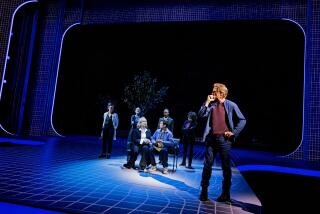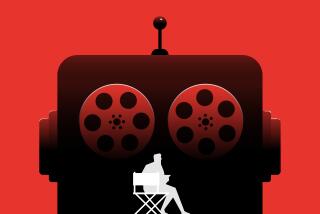UCLA Instructorâs Book on Computer-Designed Theatrical Sets Breaks New Ground
UCLA Associate Prof. Rich Rose says he will never forget the sabbatical he took from January to March of last year. He wrote a book on computer-aided scene design. And he became a father for the first time.
As a professor in the theater arts department, Rose, 38, planned the leave so that he could meet his publisherâs June deadline and still have time to spend with his new daughter, Melissa. But he never anticipated how demanding fatherhood could be. His wife, Leslie, 32, explains:
âI had an emergency Cesarean section the end of that February, and so Rich took care of the baby just as much as I did those first few months. Melissa had colic, and I was too weak to carry her around, so Rich laid her on one of his arms while he wrote on the computer with the other. It was quite a juggling act. Then we put her in a swing in his office, and she watched him for hours while he worked on the book.â
The 272-page reference manual titled âAutoCAD Onstageâ is the first book that explains how to sketch, design and draft theater, film and television sets on a computer by adapting a general computer-aided design (CAD) software program. The program, AutoCAD, has been used since 1982 by architects and engineers.
The manual will be available in bookstores this month. Half of it explains how to select computer commands to create drawings, and the remainder includes illustrations that demonstrate the steps to complete a ground plan--an overhead view of a stage that shows the placement of scenery, furniture and props.
When he introduced the program to his students, they wanted to know what the examples of exteriors and interiors of buildings had to do with theater, said Rose, a calm and somewhat studious man with blue eyes behind gold-rimmed glasses. âOut of my frustration came the idea for the book. I wanted every example to relate to the theater or the entertainment industry.â
Rose, who lives in Sepulveda with his wife and daughter, spent a year developing projects that would teach students how to draw ground plans and renderings so they would know how to apply the program when it was time for them to design or draft a show. During his year of research, Rose experimented with the program in his scene design and drawing classes. And last summer, after submitting a completed manuscript to his publisher, Betterway Publications, he began using it in his advanced drafting course.
âMy students like to use computers because their drawings are more accurate,â Rose said. âMy challenge in writing the book was to simplify the reference manual normally used with the software program, and to explain scene design to my students in an orderly fashion. A few of them have already used it to design some of our main season productions.â
The 8 1/2-by-11-inch book describes how to depict the stage by activating commands on a computer. Lines and circles can be drawn at specific dimensions or angles; objects can be moved and rotated; and the final product can be shaded, printed out and later converted into a painting, to be used as the basis for a design of a stage production, film or television show.
âCAD hasnât taken hold yet in the industry because of pure ignorance and a fear of learning new techniques,â said veteran art director Jeff Goldstein, 40, who has designed sets on such television series as âHill Street Blues,â âL.A. Lawâ and âCop Rock.â âI believe CAD will eventually become commonplace. It effectively saves time and does better presentation work with fine-line detail.â
Rose has used computers to design sets since 1987, after receiving a $100,000 grant from IBM to create a computer lab in the theater arts department. Since then he has used computers to design UCLA main stage productions of William Shakespeareâs âRomeo and Julietâ and Sam Shepardâs âCurse of the Starving Class,â which is illustrated on the cover of his book.
From 1976 to 1978, after receiving bachelorâs and masterâs degrees from UCLA in theatrical scene design, Rose worked as a set decorator and assistant art director on the ABC television shows âWhatâs Happening,â âCarter Countryâ and âSoap.â But he missed the creativity of designing for the theater, he said.
As a member of the UCLA theater arts department faculty since 1978, he has been able to design, lecture and write. A precursor to the current book was âDrafting Scenery for Theater, Film and Television.â And he has still found time to create sets for the Back Alley Theatre in Van Nuys.
But now that âAutoCAD Onstageâ has been completed, he may be spending additional hours in the classroom. During the spring quarter, he is using the text to teach a graduate class on computer-assisted design for the stage, and he continues to utilize the manual in his 10-week advanced drafting course, which meets twice a week for two hours each session.
One recent Tuesday morning, five of his undergraduate drafting students were staring at their monitors, glancing fleetingly at the manuscript pages sprawled beside them. One student was drawing a turquoise-colored three-dimensional cube on her screen; another was giving dimension to a fence. âRich and his book have made me excited about designing,â said Ed Staudenmayer, 20, an acting student who hopes one day to own a theater.
âHaving the ability to apply AutoCAD to design is going to make it easier for me to find a jobâ as an art director, 21-year-old Kristan Andrews said.
Even as college students introduce their innovative high-tech ideas to the entertainment industry, expense remains a major obstacle. According to AutoCAD retailer Jerry Eyrich, software sells for $3,500, and hardware costs $4,000 to $15,000, depending on the complexity of the system.
Bruce Ryan, 37, production designer on the CBS television series âGood Sports,â maintains his own AutoCAD computer setup at his Hollywood office. âIt pays off in the time I save,â Ryan said. âInitially it takes longer to input a design in the system than it does to draw it by hand, but in a sitcom or soap where the sets are repeated daily in part or in whole, CAD can be very advantageous because already-used ground plans can be called up and then modified.â
Although some art directors are still reluctant to use computers in the design process, Academy Award-winning production designer Gene Allen, executive director of the Society of Motion Picture and Television Art Directors, Local 876, has arranged a computer training program for the unionâs 400 members. âThere are brushes and there are pencils,â he said, âbut there are also computers, and all three are tools of the trade.â
Might Roseâs book be destined to become a fourth tool? âItâs a much-needed publication,â Ryan said.
More to Read
The biggest entertainment stories
Get our big stories about Hollywood, film, television, music, arts, culture and more right in your inbox as soon as they publish.
You may occasionally receive promotional content from the Los Angeles Times.










